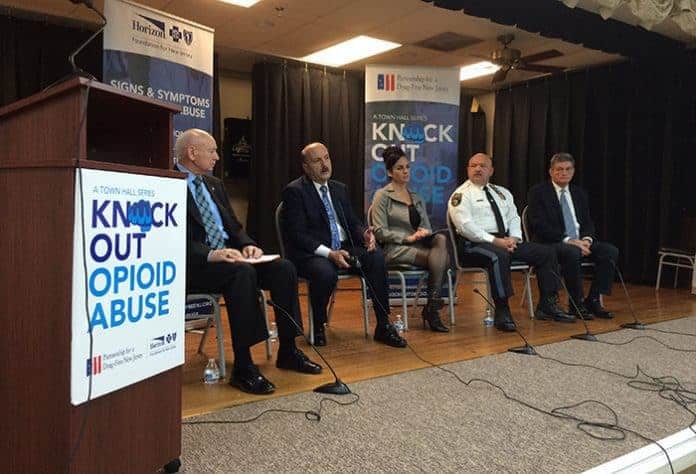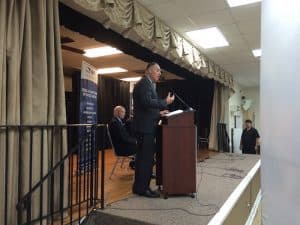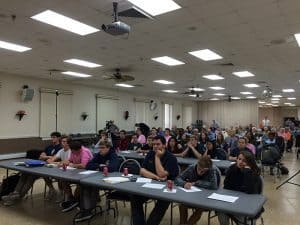
BRICK – The problem of addiction goes beyond just the chemical need for drugs, officials said. The discussion was held during a recent town hall-style meeting at the Greenbriar 1 clubhouse as part of a series of events to Knock Out Opioid Abuse. There were a few dozen local residents in attendance, as well as members of the Brick Memorial High School Key Club.
Ocean County Prosecutor Joseph Coronato explained that the current mix of heroin and fentanyl is what is killing so many people.

It can only be stopped by attacking it on three fronts, he said. The first is education, to keep people from trying drugs in the first place. The second is enforcement, to arrest dealers who prey on people. The third is to break the cycle of addiction.
Several local police departments have instituted the Blue Hart (Heroin Addiction Recovery Treatment) program, where users are able to turn in their drugs without charges and be screened for addiction programs. The county works with Preferred Behavioral Health Group and Hackensack Meridian Health.
Kelli Chiarello, the Behavioral Health Clinical Program Manager for Hackensack Meridian, was also one of the speakers. She said that part of the counseling is to have someone talk to them who is “a peer or someone trained to be open-minded.”
Addiction comes from multiple sources, and it is often a mix, she said. There could be people who are genetically pre-disposed to addiction. They could have been through something that makes them need it psychologically. Also, drugs can just be common in their environment.
“These opiates and heroin work because it feels good” to them, she said. Even if someone tells them that the drugs are having a harmful effect, they don’t feel that yet. “They’re hearing it, but in their world, it doesn’t make sense.”
Brick Police Chief James Riccio said that there were 16 overdoses in Brick in 2015. In 2016, that had skyrocketed to 108. In 2017, they were at more than 200.
“The traditional way of addressing the problem wasn’t working,” he said.

Riccio stressed that the people overdosing were not the “stereotypical addict.” They were people in good neighborhoods, who were engaged in the community.
That’s why education has to start as young as possible, he said. Additionally, adults need to be trained on what to look for in addictive behavior. Adults also need to clear out the medicine cabinets since many addicts start with prescription painkillers.
Last year, Brick collected 1,582 pounds of unused pills, he said. This year, since Blue Hart started, they have seen about 250 people.
“I’ll come in the morning, and people are in our lobby with pillows and luggage, waiting to go to treatment,” he said.
After they are screened by police, they are sent to either Hackensack Meridian or Preferred Behavioral. Anthony Castellano is a social worker with Preferred. He said that there is a misconception that once you go through treatment, you’re cured. There needs to be ongoing care to prevent an addict from going back to drugs. Often, the counselors want a loved one there to explain post-treatment care so that they can keep the recovering addict from relapsing.
“You can get someone clean, but once the cravings come back, they’ll go back to using,” he said.
There are medicines to dampen the cravings, but they are expensive and aren’t always covered by insurance, he said. However, the actual addiction is often a symptom of something greater.
“Everyone with an addiction has an underlying issue,” he said. “If you don’t get to that issue, they may not be cured.”

During a question and answer period, Coronado elaborated on this last point. He said that 75 percent of the addicts they’ve engaged with have mental health issues.
Riccio said that a lot of addiction starts with a simple injury. “Doctors just want to stop your pain,” so they prescribe painkillers.
One of the students asked if the legalization of marijuana would help ease the epidemic.
“There’s no denying that marijuana can be used medicinally,” Chiarello said. However, in this case it would act as a gateway drug. “It’s not a replacement. It’s just a Band-Aid.”
Two residents said that the court system treats people as addicts even after they’ve been clean, and future employers see it as a big blot on their record. It’s hard to move on after having an addiction because everyone – even the police – still sees you as an addict.
Coronato said that people still have to answer for any crimes they committed while being an addict. It’s part of the dues that have to be paid in order to get back into the work force.
The town hall series was co-organized by the Partnership for a Drug-Free New Jersey and the Horizon Foundation for New Jersey.






